Deciding on the right equipment for your home gym can be a bit of a puzzle. One question I often hear is, “Do I need a power rack?”
It’s a significant piece of equipment, both in size and investment after all.
In this article, we’ll explore the ins and outs of power racks, their benefits, and whether it’s the right fit for your home gym setup.
Let’s get started!
On This Page
Key Takeaways
| Main Topics | Quick Answers |
|---|---|
| Necessity of Power Rack | Essential for heavy lifting, safety, and versatility. |
| Ideal Users for Power Racks | Best for those prioritizing safety, aiming for strength, muscle building, and diverse barbell exercises. |
| Power Rack vs Squat Rack | Power rack for heavy lifting and safety; squat rack for space-saving and budget-friendly needs. |
| Space and Budget Considerations | Power racks require more space and budget; alternatives like squat racks or Smith machines for tighter spaces and budgets. |
| Training Focus | Power racks for strength and muscle building; squat racks or Smith machines for moderate lifting or specific isolation exercises. |
| Safety Features | Power racks offer adjustable safety bars for solo training; squat racks have limited safety features. |
| Versatility | Power racks offer a wide range of exercises; squat racks and Smith machines are more limited. |
| Investment Worth | Power racks are a long-term investment for serious lifters; squat racks and Smith machines for casual or space-limited setups. |
| Decision Making | Choose based on training goals, space availability, and budget constraints. |
What is a Power Rack?

A power rack is a sturdy, steel frame used in weight training.
It’s designed for safety and versatility, allowing you to perform heavy lifts like squats and bench presses without a spotter.
The rack includes adjustable safety bars to catch the barbell if you can’t complete a lift, making it a reliable and essential tool for serious lifters.
Those Who Need A Power Rack

When it comes to setting up a home gym or enhancing your workout space, deciding on the right equipment is crucial.
One piece that often comes up in these discussions is the power rack. It’s not just another piece of gym equipment; it’s a cornerstone for many.
Let’s talk about who really benefits from having a power rack and why it might be a key addition to your training setup.
Prioritizing Safety in Your Workouts
Safety is a big deal, especially when you’re lifting heavy. A power rack is a must-have for those who put safety at the forefront of their training.
With its sturdy structure and safeties, a power rack allows you to push your limits without the fear of dropping weights or getting trapped under a barbell.
This is especially crucial if you often train alone.
The peace of mind knowing you can safely bail out of a heavy squat or bench press can be a game-changer in your training intensity and progress.
This video from Omar Isuf goes over how to squat heavy alone. Using a squat rack is much safer and you can see why based on his video!
Maximizing Exercise Variety and Expansion
A power rack is ideal for those who crave a wide range of exercises and the option to expand their workout repertoire.
With a power rack, you’re not just limited to a few movements; it opens up a world of possibilities.
From squats and bench presses to pull-ups and beyond, the rack’s versatility allows for a comprehensive strength training routine.
Plus, you can always add attachments for even more variety.
Aiming for Peak Strength
If your goal is to gain maximum strength, a power rack is essential. It supports heavy lifting in a safe environment.

You can progressively increase your weights without the need for a spotter, pushing your limits securely. This is crucial for effective strength training.
Building Muscle Mass
For those focused on getting bigger, a power rack is a solid addition. It’s perfect for heavier movements that you can train to failure on.
Power racks allow you to safely overload due to the safeties catching the bar when you fail.
This makes it perfect for those who really want to push their lifts to the breaking point without getting injuries.
Focusing on Barbell Exercises
If barbell exercises are your priority, a power rack is a must-have. It’s designed to support a wide range of barbell movements safely.
Whether it’s squats, or presses, the power rack provides the stability and safety you need to perform these exercises effectively.
Those Who DON’T Need A Power Rack
While a power rack can be a fantastic addition to many workout routines, it’s not a one-size-fits-all solution.
There are certain scenarios and training styles where a power rack might not be necessary or even the best choice.
Let’s explore who might not need a power rack and why other options could be a better fit.
You’re An Olympic Lifter

If you’re primarily into Olympic lifting, a power rack might not be essential for you.
Olympic lifts often involve dynamic movements and dropping the bar from a height, which isn’t what a power rack is designed for.
In these cases, a platform designed for Olympic lifting with bumper plates is more appropriate.
Combine this with a squat stand and you have all of your bases covered for the most part.
Limited Space and Alternative Rack Options
Not everyone has the luxury of ample space for a full-sized power rack.
If space is a constraint, you might want to consider alternatives like half racks, squat stands, or folding racks.
These options take up less room and can still support a variety of exercises, making them a practical choice for smaller home gyms.
If Lifting Heavy Isn’t Your Goal
For those who aren’t aiming to lift extremely heavy weights, a power rack might be more than what’s necessary.
Your training might not require the robust structure and safety features that a power rack offers, especially if you’re focusing on moderate weights.
Cardio and Conditioning Focus
If your training is more cardio and conditioning-focused, with less emphasis on heavy lifting, then investing in a power rack might not align with your fitness goals.
Equipment like rowing machines, treadmills, or even free weights such as dumbbells and kettlebells might be more in line with your workout needs.
Power Rack vs Squat Rack
When setting up a gym, choosing between a power rack and a squat rack is a common dilemma.
Let’s break down what a squat rack is and compare its pros and cons to power racks to help you make an informed decision.
What is a Squat Rack?
A squat rack is simpler than a power rack. It’s essentially a frame that holds the barbell at a height suitable for exercises like squats and overhead presses.
It’s more open compared to a power rack, usually consisting of two vertical posts with adjustable heights.
Pros and Cons of a Squat Rack
PROS
CONS
Pros and Cons of a Power Rack
PROS
CONS
Squat Rack vs. Power Rack
Choosing between the two depends on your needs. If you’re tight on space and budget, and your workouts don’t involve extremely heavy lifting, a squat rack might be sufficient.
However, if you’re planning to lift heavy, prioritize safety, and have the space, a power rack is undoubtedly the better choice.
It offers more stability, safety, and versatility for a wide range of exercises.
How To Use A Power Rack
Using a power rack is pretty straightforward.
First, adjust the J-hooks to the height you need for your exercise – whether it’s squats, bench presses, or overhead presses. This is where you’ll set your barbell.
Next, set the safety bars. These should be at a height where they’ll catch the barbell if you fail a lift, but not so high that they interfere with your full range of motion.

Once your setup is right, you’re good to go. Load your barbell, and start your exercise. The power rack is there to support you if you can’t complete a rep.
It’s that simple – the rack ensures you can train hard and heavy, but safely.
Remember, regular checks and adjustments to the rack setup are key to keeping your workouts both effective and safe.
What About Smith Machines?
Now, let’s talk about Smith machines. These are often seen in gyms and have a barbell fixed within steel rails, allowing only vertical or near-vertical movement.
They’re great for certain exercises, especially if you’re new to lifting or working out alone without a spotter.
The Smith machine has its place, particularly for those focusing on specific types of lifts or who prefer the stability it offers.
It’s excellent for controlled movements and can be a good tool for isolating specific muscle groups.

However, it’s worth noting that because of its fixed path, it doesn’t engage stabilizing muscles as much as free weights do.
This doesn’t really matter though as it’s a much better option for hypertrophy than strength anyway.
While Smith machines are useful, they don’t offer the same versatility or full-body engagement you get with free weights in a power rack or squat rack.
They can be a part of a well-rounded gym setup but shouldn’t be the sole focus if you’re aiming for comprehensive strength training.
Conclusion
So, do you need a power rack? It really boils down to your specific training goals and the space you have.
If you’re serious about strength training, especially if you’re lifting heavy or want the safety and versatility a power rack offers, then it’s a solid investment.
For those with limited space or a focus on lighter, more varied workouts, a squat rack or even a Smith machine might be more appropriate.
Evaluate your fitness objectives and the practicalities of your workout area to make the best choice for your home gym.
Until next time,
-Dante